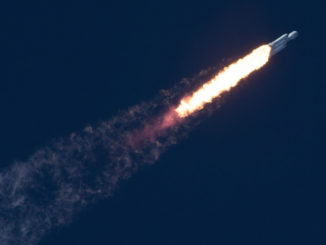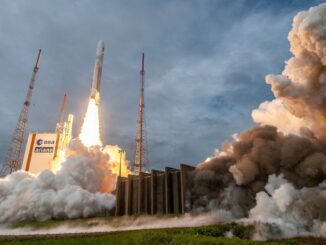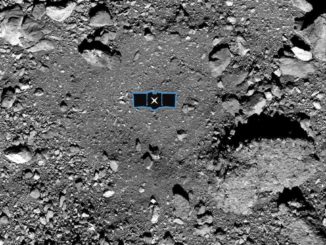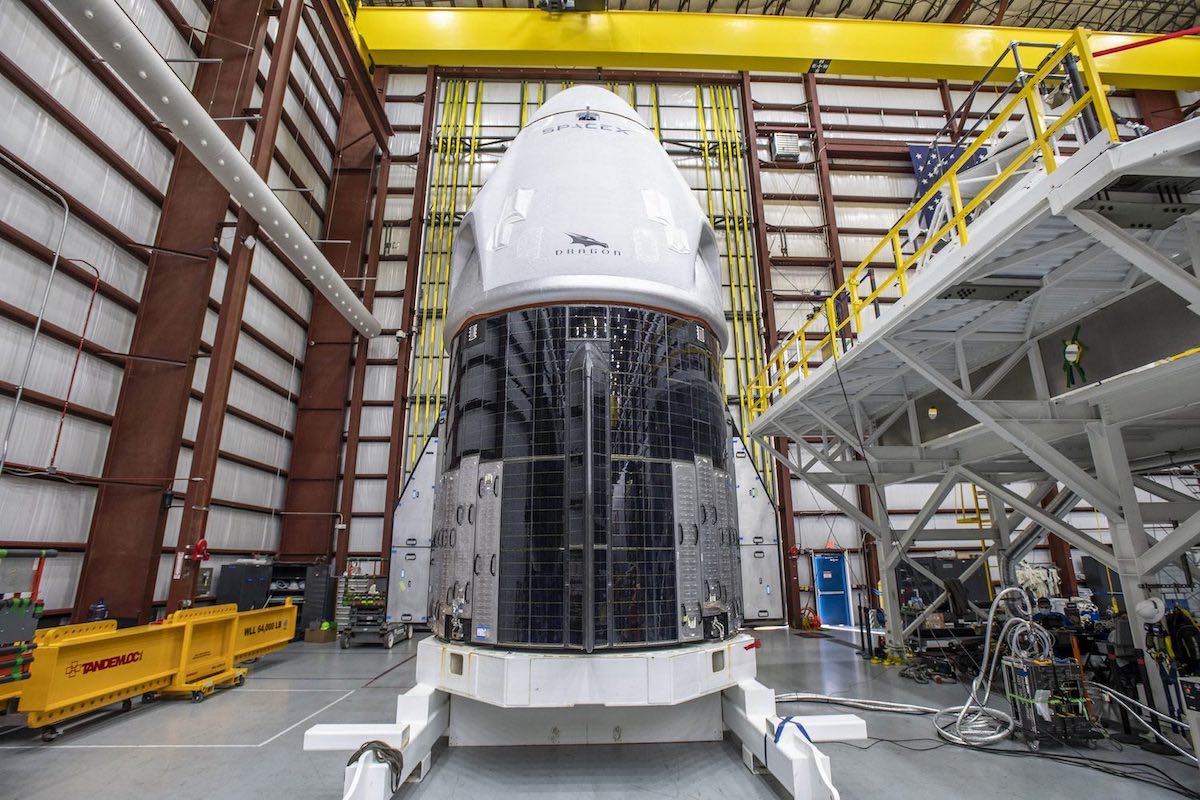
Fully fueled for a flight to the International Space Station later this month, SpaceX transferred the Crew Dragon “Resilience” spaceship Thursday to a hangar near pad 39A at the Kennedy Space Center for attachment to its Falcon 9 launcher.
The commercial crew ship arrived in SpaceX’s hangar near the southern perimeter of 39A on Thursday. SpaceX technicians inside the building will connect the Crew Dragon with a Falcon 9 rocket before rolling the fully-assembled launcher up the ramp to pad 39A this weekend.
The commercial crew capsule is scheduled for launch Nov. 14 at 7:49 p.m. EST (0049 GMT on Nov. 15) with four astronauts aboard. The mission is known as Crew-1, and it will be the first operational flight of SpaceX’s Crew Dragon spacecraft following a 64-day test flight to the space station earlier this year with astronauts Doug Hurley and Bob Behnken.
The Crew Dragon spacecraft for the Crew-1 mission is named “Resilience,” a name that commander Mike Hopkins said he hopes “can be an inspiration for everybody on what’s possible when we work together.”
“As you look at the definition of resilience, it means functioning well in times of stress or overcoming adverse events, so I think all of us agree that 2020 has certainly been a challenging year — a global pandemic, economic hardships, civil unrest, isolation — and despite all of that, SpaceX (and) NASA have kept the production line and finished this amazing vehicle that’s getting ready to go on its maiden flight to the International Space Station,” Hopkins said.
“On our patch, you’ll notice that on the border, there’s no names, there’s no flags, and that was by design because that patch doesn’t really represent the four of us, but it really represents the countless people that have contributed to getting the vehicle ready and getting us ready for this mission,” Hopkins said in a press conference in September.
“That same theme applies to the name of this vehicle, Resilience, it is not just a connection for the four of us, but we really feel like it is a connection to all of you, to everybody,” Hopkins said. “We hope that it brings a smile to your face. We hope that it provides something positive in your lives, and quite frankly, that it’s an inspiration — that it shows when you work together that there’s no limit to what you can achieve.”
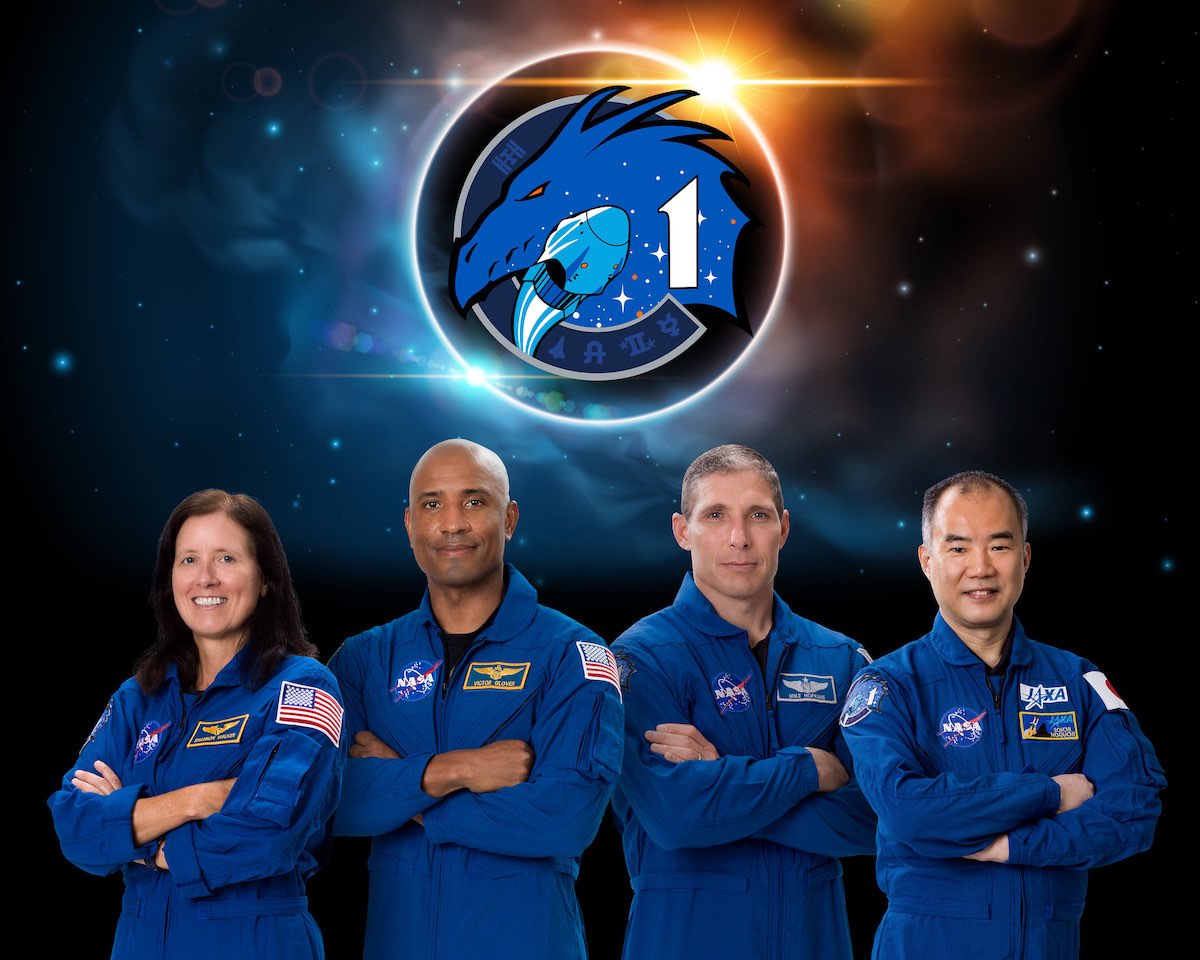
In an interview with Spaceflight Now, Hopkins said he expects the name Resilience will stay with the Crew Dragon spaceship — also known by SpaceX as Dragon C207 — on future flights of the reusable capsule. Hurley and Behnken selected the name Endeavour for the Crew Dragon spacecraft on their demonstration flight, known as Demo-2.
The Crew Dragon Endeavour capsule is being refurbished for another flight to the space station on the Crew-2 mission in the first half of 2021. The Crew-2 astronauts will replace Crew-1 on the space station after a half-year in orbit.
Hopkins said the Crew-2 astronauts do not intend to rename the Crew Dragon Endeavour.
“So that (name) is going to stick with that vehicle, and I would anticipate the same thing on ours,” Hopkins said.”Sometimes vehicles like ships are renamed when they’re passed from one owner to another, but in this particular case, it’s staying in family, it’s staying with the company, so I would be surprised if it’s renamed, but obviously folks may decide that way.”
Dragon’s transfer to hangar signals start of final phase of launch campaign
The Crew Dragon Resilience was transported by road from a fueling facility at nearby Cape Canaveral Air Force Station to pad 39A. Before its move to the launch pad, the spacecraft was filled with hypergolic hydrazine and tetroxide propellants for the capsule’s launch escape engines and orbital maneuvering thrusters.
The ship’s Falcon 9 launcher was already inside the hangar at the southern perimeter of the launch pad, the same seaside complex where Apollo moon missions and space shuttles departed Earth.
Once SpaceX technicians confirm mechanical and electrical connection between the spacecraft and the rocket, the entire 215-foot (65-meter) vehicle will roll out to pad 39A and raised vertical for a test-firing of the Falcon 9’s Merlin main engines Monday evening.
The successful launch of another Falcon 9 rocket from Cape Canaveral Air Force Station Thursday night was a key milestone leading up to the Crew-1 mission. The Falcon 9 successfully deployed a GPS navigation satellite for the U.S. Space Force, confirming that engineers have apparently resolved an issue with Merlin engines that delayed the GPS mission and the Crew-1 flight.
Hopkins, pilot Victor Glover, mission specialist Shannon Walker, and Japanese astronaut Soichi Noguchi are scheduled to arrive at the Kennedy Space Center via a NASA Gulfstream jet Sunday afternoon around 2 p.m. EST (1900 GMT).
A Flight Readiness Review convened by top NASA officials is also scheduled Monday to discuss unresolved technical issues, review the status of launch preparations, and give formal approval for teams to proceed with the Crew-1 mission.
Hopkins and his crewmates will put on their SpaceX-made pressure suits Wednesday for a “dry dress rehearsal” of their launch day activities. The four astronauts will ride inside two Tesla Model X automobiles from crew quarters at the Kennedy Space Center to pad 39A, where they will board the Crew Dragon Resilience.
Once the rehearsal is complete, the crew members will exit the spacecraft and return to crew quarters.
SpaceX plans a Launch Readiness Review Thursday, another checkpoint to officially sign off on the Crew-1 mission’s scheduled launch next Saturday, Nov. 14.
Assuming an on-time launch at 7:49 p.m. EST on Nov. 14, the Crew Dragon Resilience is scheduled to autonomously dock with the International Space Station around eight-and-a-half hours later at 4:20 a.m. EST (0920 GMT) on Nov. 15.
A few hours after docking, Hopkins and his crewmates will open hatches to join Russian commander Sergey Ryzhikov, flight engineer Sergey Kud-Sverchkov, and NASA astronaut Kate Rubins on the station — raising the lab’s long-duration crew complement up to seven people for the first time.
“I think one of the distinctions to be made between Demo-2 and our mission is they were more of a development and demonstration part, and we’re really more of the operational,” Hopkins told Spaceflight Now in a pre-flight interview. “So we’re going to be putting the vehicle through its operational paces.
“What that means is we’re figuring out how four people are going to live and operate on-board the vehicle during that free flight phase, but we’re also bringing longer duration and things of that nature,” Hopkins said. “So even though the first one was a test mission, this one does have some of that flavor to it as well because we’re going to be up there for four or more months longer than Bob (Behnken) and Doug (Hurley) were, so we’re going to be monitoring very closely how the vehicle handles the space environment for that length of time.
“In general, I think it’s more of an operational checkout than development testing,” Hopkins said.
Hopkins, 51, is a colonel in the U.S. Air Force and served as a flight test engineer before his selection as a NASA astronaut in 2009. He completed a 166-day expedition on the space station in 2013 and 2014 before NASA named him to command the first operational Crew Dragon mission in 2018.
He said the Crew-1 flight plan does not include any manual piloting tests like the demonstrations performed by Doug Hurley on the Demo-2 mission. If all goes according to plan, the Crew Dragon Resilience will link up with the space station in autopilot mode.
“We have certainly been trained in the manual piloting phase, but that is if there is any kind of a contingency or any failures on-board that would force us to go to manual piloting,” Hopkins said.
Email the author.
Follow Stephen Clark on Twitter: @StephenClark1.

